The ASTI Data in Focus series provides additional background data in support of the 2010 Country Note on Sudan (asti.cgiar.org/pdf/Sudan-Note.pdf) prepared by the Agricultural Science and Technology Indicators (ASTI) initiative and the Agricultural Research Corporation (ARC). Based on data collected by ASTI and ARC, these two outputs review major investment and capacity trends in Sudanese public agricultural research and development (R&D) since 1971, providing important updates on agricultural R&D trends prepared by ASTI and ARC in 2002 - 03.
C. Human Resources
This section provides detailed quantitative information on full-time equivalent (FTE) agricultural research and support staff trends including qualifications, gender and age distribution, and support-staff-per-researcher ratios. Supplementary sections present detailed data on long-term trends (Section A), financial resources (Section B) and research allocation (Section D). Other supporting information provides macroeconomic trends, a list of agencies included in the study, data sources and estimation procedures, and ASTI's methodology.
Table C1–Total researcher levels across various agencies, 2008
In 2008, the Agricultural Research Corporation (ARC) accounted for almost half of Sudan's total agricultural R&D capacity, employing 473 full-time equivalent (FTE) researchers. The Animal Resources Research Corporation (ARRC) accounted for 20 percent of capacity, employing 199 FTE researchers. The two other government agencies together employed 38 FTE researchers or 4 percent of agricultural R&D capacity. The University of Khartoum (UofK), the country's leading university in terms of agricultural researchers, employed 127 FTEs in 2008. Combined, the higher education agencies employed 310 FTE researchers, accounting for 30 percent of capacity in 2008.
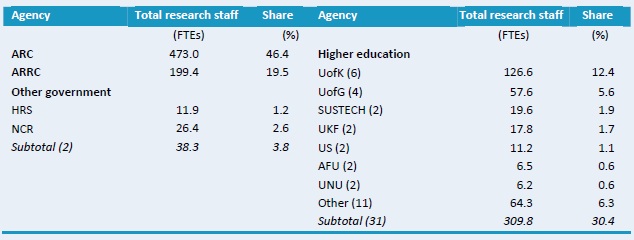
Source: Calculated by authors from ASTI - ARC 2010.
Notes: Figures in parentheses indicate the number of agencies in each category. For more information on coverage and estimation procedures, see the Sudan country page on ASTI's website at asti.cgiar.org/sudan/datacoverage ; for a complete list of the agencies included in the sample, see asti.cgiar.org/sudan/agencies.
Figure C1– Full-time equivalent researcher trends at ARC by degree, 1991 - 2008
ARC's research capacity increased considerably between the 1990s and 2005. Increases occurred across all degree levels but most significantly at the MSc level, given that the number of MSc-qualified researchers more than tripled during 1991?2005. After 2005, the total number of researchers began to decline, reaching 473 FTEs in 2008.
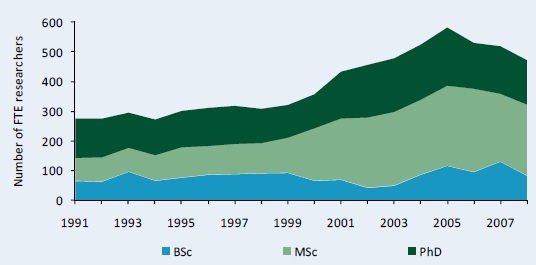
Source: Calculated by authors from ASTI - ARC 2010 and Beintema and Faki 2003.
Note: For more information on coverage and estimation procedures, see the Sudan country page on ASTI's website at asti.cgiar.org/sudan/datacoverage
Figure C2–Full-time equivalent researcher trends at other government agencies by degree, 1997 - 2008
The number of researchers employed at the government agencies HRS and NCR increased significantly, from 12 FTEs in 2000 to 38 FTEs in 2008. Researcher numbers increased across all degree levels. The number of researchers holding PhD degrees increased from 5 to 9 FTEs, whereas the number of researchers holding MSc degrees doubled, from 8 to 16 FTEs.
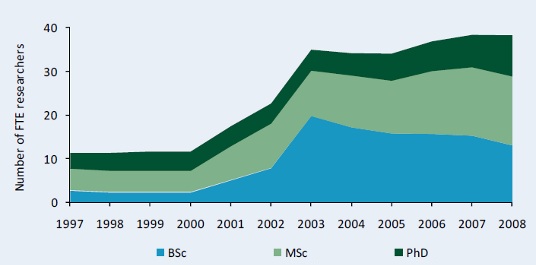
Source: Calculated by authors from ASTI - ARC 2010 and Beintema and Faki 2003.
Note: For a complete list of agencies included in the sample, see asti.cgiar.org/sudan/agencies.
Figure C3–Full-time equivalent researcher trends at 17 higher education agencies by degree, 2001 - 08
During 2001 - 08, the number of researchers employed at a sample of 17 higher education agencies rose steadily. They also became more highly qualified, given that the number of researchers with PhD degrees increased significantly, from 73 FTEs in 2001 to 122 in 2008.
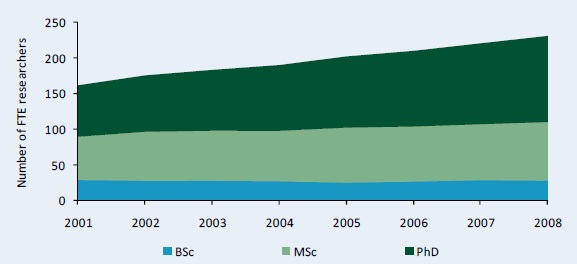
Source: Calculated by authors from ASTI - ARC 2010 and Beintema and Faki 2003.
Note: For a complete list of agencies included in the sample, see asti.cgiar.org/sudan/agencies.
Figure C4–Distribution of researcher qualifications across various agencies, 2008
At ARC, 32 percent of researchers were PhD qualified and 51 percent held MSc degrees in 2008. At ARRC, fewer researchers held postgraduate degrees (27 percent were PhD qualified and 34 percent were MSc qualified). Of the other government agencies, NCR had similar shares to ARRC, while HRS's share of MSc-qualifed researchers was higher (59 percent). Consistent with findings worldwide, on average, the higher education agencies employed more PhD-qualified researchers than the government or nonprofit agencies (over 50 percent). Shares of researchers with PhD degrees varied widely across the universities, however, from 17 percent at Dalanj University (DU) to 58 percent at the University of Khartoum (UofK).
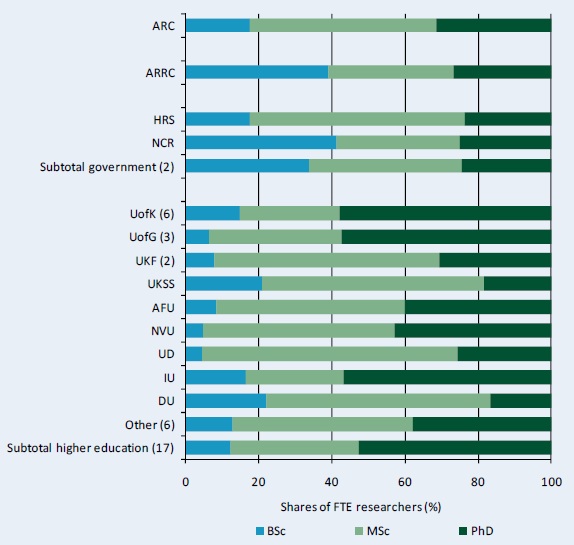
Source: Calculated by authors from ASTI - ARC 2010.
Note: For a complete list of agencies included in the sample, see asti.cgiar.org/sudan/agencies.
Figure C5–Share of female researchers by degree and institutional category, 2008
The overall share of female agricultural researchers in Sudan increased significantly from 22 percent in 2000 to 34 percent in 2008. In absolute terms, the number of female researchers nearly doubled, from 111 FTEs in 2001 to 202 FTEs in 2008. However, trends in levels of female researchers varied across agencies. At ARC, the share of female researchers doubled, reaching 164 FTEs in 2008, 35 percent of total researchers at the agency. At NCR and the higher education agencies, the share of women dropped from 33 percent in 2000 to 28 percent in 2008.
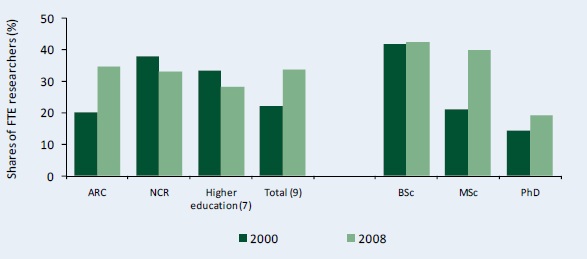
Source: Calculated by authors from ASTI - ARC 2010.
Notes: Figures in parentheses indicate the number of agencies in each category. For a complete list of agency names, see asti.cgiar.org/sudan/agencies.
Figure C6–Distribution of researcher qualifications by gender, 2000 and 2008
The share of PhD-qualified male researchers remained constant at around 40 percent during 2000 - 08, whereas the share of PhD-qualified female researchers declined from 23 to 19 percent. However, absolute numbers of female researchers with PhD degrees actually increased, but the number of those with MScs increased more (58 percent in 2008).
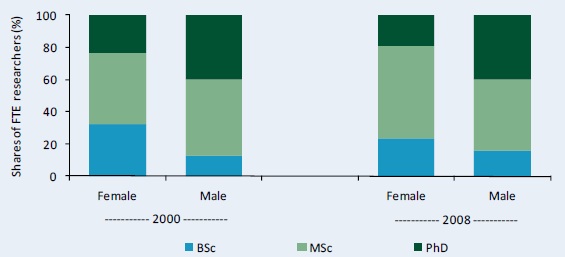
Source: Calculated by authors from ASTI - ARC 2010 and Beintema and Faki 2003.
Note: See Figure C6 for agency sample size.
Figure C7–Share of female researchers by degree across various agencies, 2008
Of the government agencies, ARRC employed the highest share of female researchers, at 48 percent, and 26 percent of these held PhD degrees. ARC employed a lower share of female researchers (35 percent), and of those, 17 percent of those held PhDs. On average, the higher education agencies employed a lower share of female researchers, 29 percent, but shares varied significantly across agencies, ranging from 8 percent at the Faculty of Agricultural Sciences of Dalanj University (FA-DU), to 57 percent at the Institute of Environmental Studies at the University of Khartoum (IES-UofK).
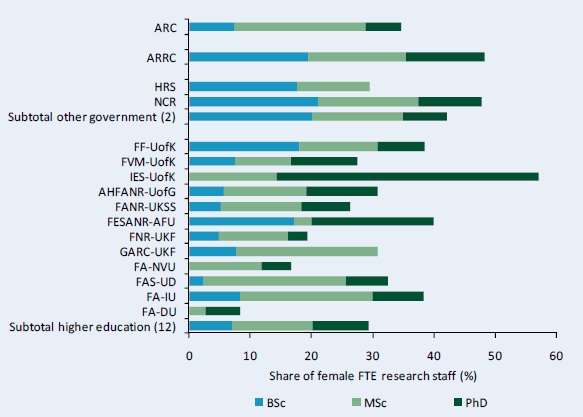
Source: Calculated by authors from ASTI - ARC 2010.
Notes: See Figure C6 for agency sample size. For a complete list of agency names, see asti.cgiar.org/sudan/agencies.
Figure C8–Trends in full-time equivalent support staff, 2001 - 08
The overall number of FTE support staff–including technicians and administrative staff–slightly increased, from 2,912 FTEs in 2001 to 3,060 in 2008. That year, one technician held a PhD degree, 20 held MSc degrees, and 176 held only BSc degrees. Nevertheless, most technicians either had no degree or held only a diploma.
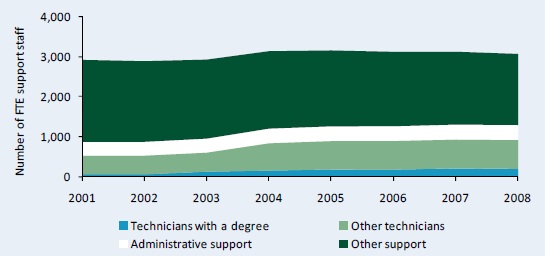
Source: Calculated by authors from ASTI - ARC 2010.
Figure C9–Support-staff-per-researcher ratios by institutional category, 2001 and 2008
FTE researcher numbers increased at a greater rate than support staff numbers from 2001 to 2008, overall support-staff-per-researcher ratios fell from 5.3 in 2001 to 4.3 in 2008. The government sector reported much higher ratios compared with the higher education sector, but this is common given that research is a secondary mandate at the higher education agencies.
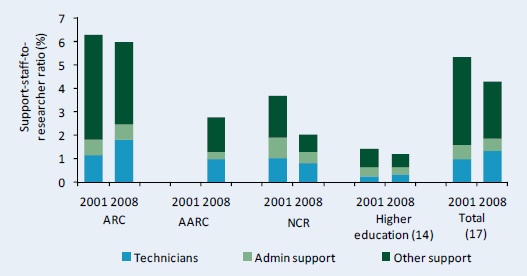
Source: Calculated by authors from ASTI - ARC 2010.
Notes: Figures in parentheses indicate the number of agencies in each category. For more information on coverage and estimation procedures, see the Sudan country page on ASTI's website at asti.cgiar.org/sudan/datacoverage.
Copyright (C) 2011 International Food Policy Research Institute and Agricultural Research Corporation. Sections of this Data in Focus issue may be reproduced without the express permission of, but with acknowledgement to, IFPRI and ARC. This series has been prepared as an output for the ASTI initiative and has not been peer reviewed. Any opinions stated herein are those of ASTI and do not necessarily reflect the policies and opinions of IFPRI or ARC.
